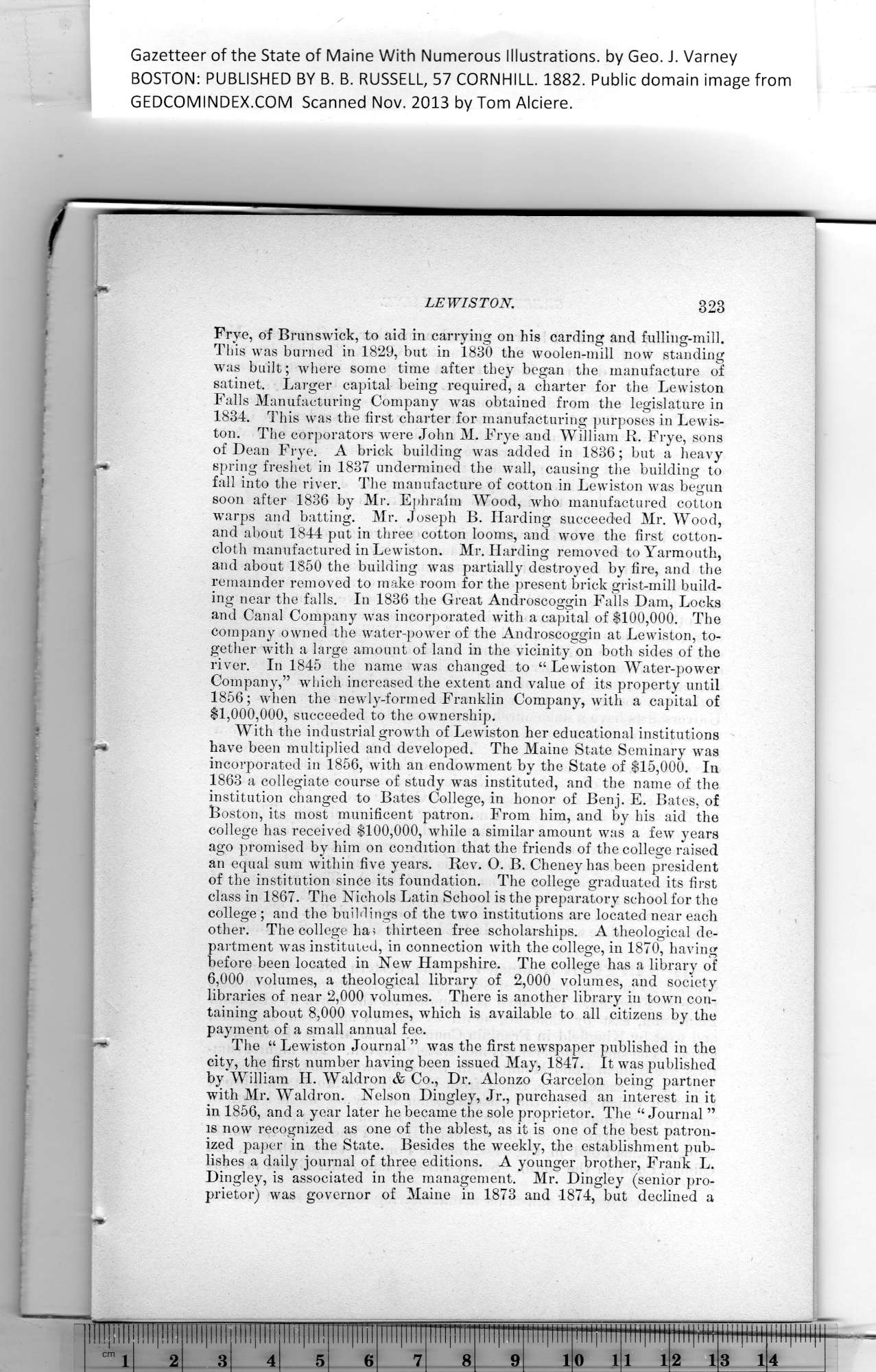|
Gazetteer of the State of Maine With Numerous Illustrations, by Geo. J. Varney
BOSTON: PUBLISHED BY B. B. RUSSELL, 57 CORNHILL. 1882. Public domain image from
LEWISTON. 323
Frye, of Brunswick, to aid in carrying on his carding and fulling-mill.
This was burned in 1829, but in 1830 the woolen-mill now standing
was built; where some time after they began the manufacture of
satinet. Larger capital being required, a charter for the Lewiston
Falls Manufacturing Company was obtained from the legislature in
1834. This was the first charter for manufacturing purposes in Lewis-
ton. The corporators were John M. Frye and William R. Frye, sons
of Dean Frye. A brick building was added in 1836; but a heavy
spring freshet in 1837 undermined the wall, causing the building to
fall into the river. The manufacture of cotton in Lewiston was begun
soon after 1836 by Mr. Ephraim Wood, who manufactured cotton
warps and batting. Mr. Joseph B. Harding succeeded Mr. Wood,
and about 1844 put in three cotton looms, and wove the first cotton-
cloth manufactured in Lewiston. Mr. Harding removed to Yarmouth,
and about 1850 the building was partially destroyed by fire, and the
remainder removed to make room for the present brick grist-mill build-
ing near the falls. In 1836 the Great Androscoggin Falls Dam, Locks
and Canal Company was incorporated with a capital of $100,000. The
company owned the water-power of the Androscoggin at Lewiston, to-
gether with a large amount of land in the vicinity on both sides of the
river. In 1845 the name was changed to “Lewiston Water-power
Company,” which increased the extent and value of its property until
1856; when the newly-formed Franklin Company, with a capital of
$1,000,000, succeeded to the ownership.
With the industrial growth of Lewiston her educational institutions
have been multiplied and developed. The Maine State Seminary was
incorporated in 1856, with an endowment by the State of $15,000. In
1863 a collegiate course of study was instituted, and the name of the
institution changed to Bates College, in honor of Benj. E. Bates, of
Boston, its most munificent patron. From him, and by his aid the
college has received $100,000, while a similar amount was a few years
ago promised by him on condition that the friends of the college raised
an equal sum within five years. Rev. O. B. Cheney has been president
of the institution since its foundation. The college graduated its first
class in 1867. The Nichols Latin School is the preparatory school for the
college ; and the buildings of the two institutions are located near each
other. The college ha* thirteen free scholarships. A theological de-
partment was instituted, in connection with the college, in 1870, having
before been located in New Hampshire. The college has a library of
6,000 volumes, a theological library of 2,000 volumes, and society
libraries of near 2,000 volumes. There is another library in town con-
taining about 8,000 volumes, which is available to all citizens by the
payment of a small annual fee.
The “ Lewiston Journal ” was the first newspaper published in the
city, the first number having been issued May, 1847. It was published
by William H. Waldron & Co., Dr. Alonzo Garcelon being partner
with Mr. Waldron. Nelson Dingley, Jr., purchased an interest in it
in 1856, and a year later he became the sole proprietor. The “ Journal ”
is now recognized as one of tbe ablest, as it is one of the best patron-
ized paper in the State. Besides the weekly, the establishment pub-
lishes a daily journal of three editions. A younger brother, Frank L.
Dingley, is associated in the management. Mr. Dingley (senior pro-
prietor) was governor of Maine in 1873 and 1874, but declined a
PREVIOUS PAGE ... NEXT PAGE
This page was written in HTML using a program written in Python 3.2
|
